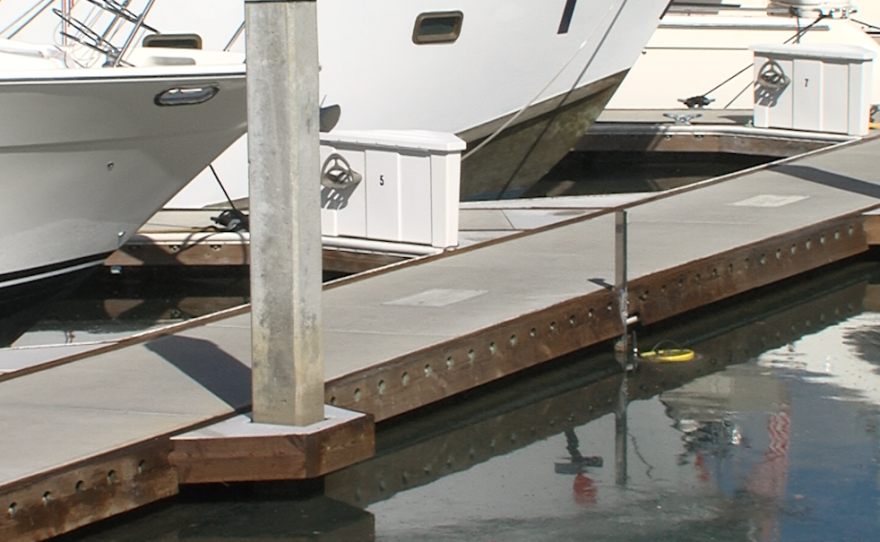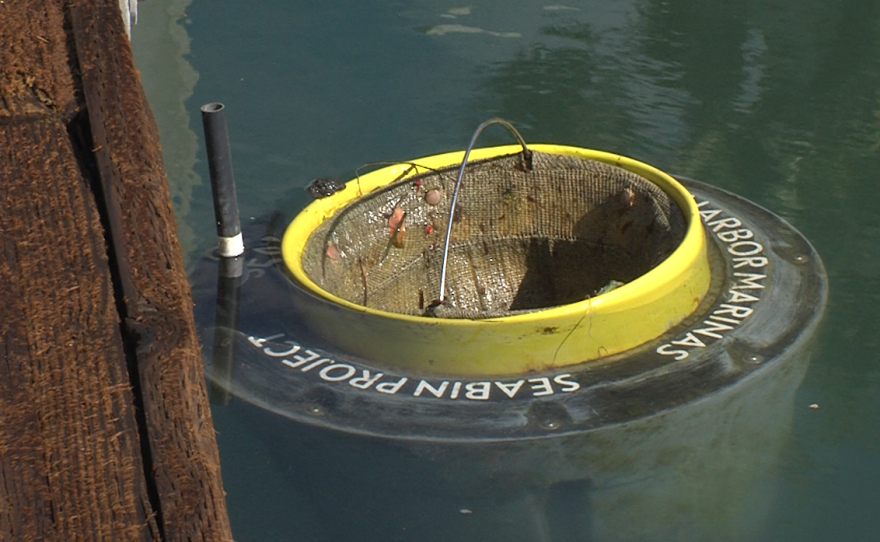One corner of the Cabrillo Isle Marina used to be what General Manager Tony Reese called a cesspool. Reese stood on the dock and pointed to the small patch in the relatively clean water. Garbage, plant waste and gasoline used to get pushed into the corner by prevailing winds and tides.
“And at high tide, it gets pulled up off the rocks and it just becomes a little scum alley and then at low tide, go back and rest on the rocks and wait for the next tide to pull it up and make the mess all over again,” Reese said.
But for the past nine months, an industrial bucket sized pump, called a Seabin, has been anchored to a dock, sucking up anything that floats. It is like a large mechanical shellfish that constantly filters water.
“As you can see it’s a very quiet device a very small device, very unobtrusive,” Reese said. “Only about two and a half feet wide by about three feet deep. It has a small pump on the bottom. So it just, non-stop throughout the day, pulls in floating debris across the surface as well as petroleum.”
The device is basically five parts: an outer case that floats, an inner shell, a basket, a filter, and a pump.
The pump creates enough suction to pull the yellow internal shell below the water line. Water flows into the basket bringing along anything else on the surface. A separate petroleum filter captures fuel floating on the top of the water.
The device is located on the dock so the pump can be plugged in, which allows the Seabin to run around the clock.
“It’s really magnified in this location where it all collects. But there is floating debris throughout every marina in the entirety of the bay and throughout the ocean. And so this is kind of just the tip of the iceberg.”
Before the filter was installed, maintenance workers collected debris with skimmers and other tools, but that work was time-consuming and not effective.
Now the pump does the work and the filter is pulled up and emptied three times a day.
“The collection bag is designed to hold about 20 pounds so on an average day we’re pulling about 60 pounds out of the water,” Reese said.
The material ends up at the marina’s recycling station.
“We collect the items from the Seabin and we separate it into non-organic and organic type,” said Ray Gonzales, Cabrillo Isle Marina maintenance supervisor.
Gonzales pulled out plastic and other items starting with the large stuff first.
“We’ll sort out most of the ones that protrude out of it. All the plastic that’s more visible. Then after that, we’ll start the raking process for getting most of it. But we first go through for all of the plastic stuff,” Gonzales said.
Plastics go to the recycling bin and organic material is added to the marina’s compost pile.

Marina tenants appreciate the cleaner water around their boats, Gonzales said, and they are frequently the first to report if there is a problem.
The clean water group San Diego Coastkeeper says these kinds of pumps can help the water quality in the bay. Matt O’Malley prefers to work on initiatives that keep trash out of the water, but he doesn’t ignore the fact that trash is already there.
“That trash and those solids and those oils, they do move around the bay. In those places they’re generally located in a tight spot so there is an opportunity to actually clean those localized spots, maybe easier than it is in the local bay,” O’Malley said.
The Seabin needs to be plugged in to work, although designers are working on a model that can use solar panels to power a pump.
The device has been filtering water at the Harbor Island marina for nine months. That trail expands to marinas in other California cities this month.
A San Diego Marina is field testing a new pump that could help clean up water in areas where boats talk. Eric Anderson says the device has been tested at a handful of locations around the world, including a spot here in San Diego.This corner of the Marina on Harbor Island used to be what general manager Tony Reese calls a cesspool. Garbage, plant ways, gasoline, or got pushed into the corner by prevailing winds and tides.In a high tide, would pull off off the rocks and become a scum alley. That would rest on the rocks and wait for the next tied to pull it up and make the mess all over again.But the past nine months, a pocket-sized pump has been anchored to the dock and it sucks up anything that floats. It is like a large mechanical shellfish that constantly filters water.As you can see, it is a very quiet device and very small. It is only about 2.5 feet wide. Is a small pump on the bottom. It is nonstop throughout the day pulling in floating debris across the surface, as well as petroleum.He says it is basically five parts, and inner shell, a basket, a filter, and a pump. The pump creates enough suction to pull a shell below the waterline. Water flows into the basket, bringing along anything on the surface. A separate petroleum filter captures fuel that floats. He says that the devices located on the docks so it can be pumped in, that allows it to run around the clock.It is really magnified in this location, where it all collects, but there is floating debris throughout every Marina throughout the entirety of the bay and the ocean, so this is just the tip of the iceberg.Before the filter was installed, and its workers collected the debris, but the work was time-consuming and ineffective. Now, the pumps filter is quickly pulled up and emptied three times a day.The collection bag is designed to hold about 20 pounds of material, on an average day, we are pulling about 60 pounds out of the water.The trash ends up at the Marina recycling station where the supervisor sifts through the material.We collect the items from the seabed, separate it into nonorganic and organic.He reaches into his trashcan and pulls out trash bags and other materials, starting with the large items first.We will sort out most of those. All of the plastic that is more visible. After that, we can start into the raking process. We first go for all the plastic stuff.Plastics go to the recycling bin and organic material is added to the marinas compost pile. They get high marks from tenants -- tenants that are impressed with the clean water on their boats.Sometimes if something happens to the system, we hear about it through our tenants first.A local clean water group says the pumps can help the bay. They say that he prefers to work on initiatives that keep trash out of the water, but does not ignore the fact that trash is up there.Those trash and solvents and oils move throughout the bay. They are generally located in a tight spot, so there is an opportunity action to clean the localized spots, maybe easier than in the open bay.It needs to be plugged in to work, although they are working on one that can use solar panels to power the pump. The device has been filtering water for nine months. The trial expands to marinas and other California cities this month.






